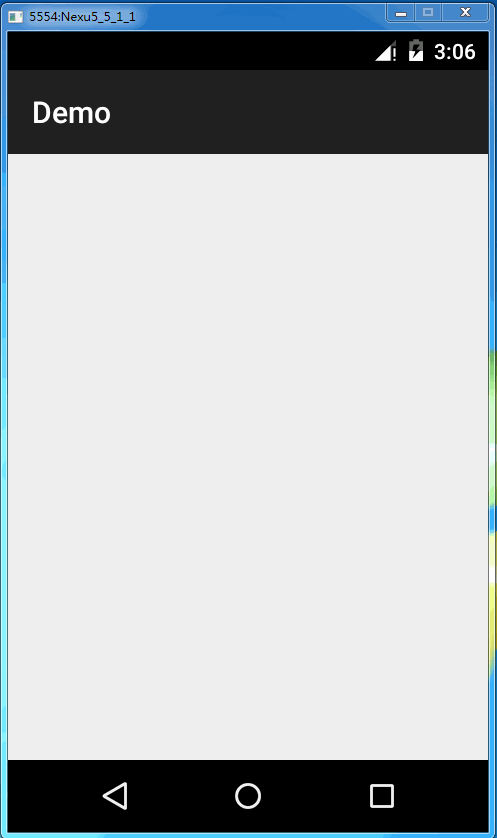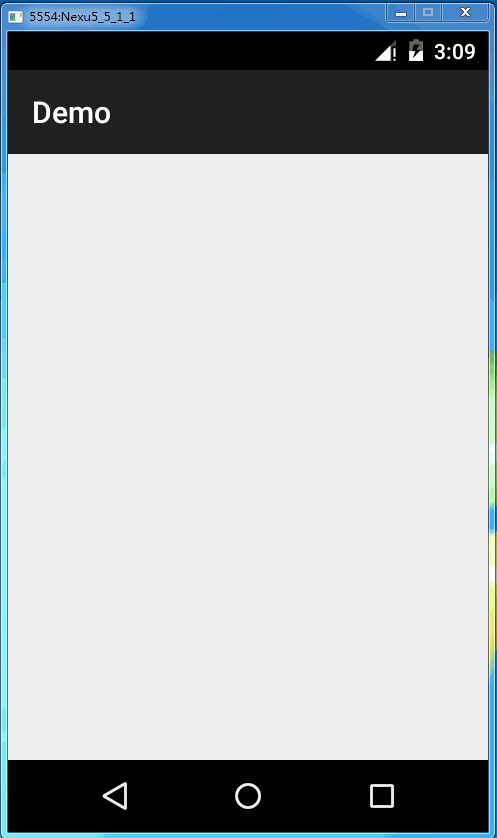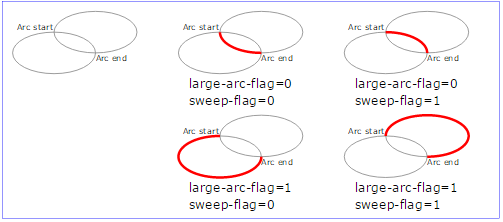Android SVG動畫PathView原始碼解析與使用教程(API 14)
使用的是一個第三方庫android-pathview主要是一個自定義View——PathView,跟所有自定義View一樣,重寫了三個構造方法。並且最終呼叫三個引數的構造方法,在裡面獲取自定義屬性。
/**
* Default constructor.
*
* @param context The Context of the application.
*/
public PathView(Context context) {
this(context, null);
}
/**
* Default constructor.
*
* @param 檢視自定義屬性的xml,裡面共三個自定義屬性,pathColor為路徑顏色,預設值為綠色0xff00ff00,pathWidth為路徑寬度,預設值為8.0f,svg為路徑檔案
<?xml version="1.0" encoding="utf-8"?>
<resources>
<declare-styleable name="PathView">
<attr name="pathColor" format="color"/>
<attr name="pathWidth" format="float"/>
<attr name="svg" format="reference"/>
</declare-styleable>
</resources>通過getFromAttributes函式獲得這些自定屬性,並賦值給成員變數,最後通過finally塊回收資源
/**
* Get all the fields from the attributes .
*
* @param context The Context of the application.
* @param attrs attributes provided from the resources.
*/
private void getFromAttributes(Context context, AttributeSet attrs) {
final TypedArray a = context.obtainStyledAttributes(attrs, R.styleable.PathView);
try {
if (a != null) {
paint.setColor(a.getColor(R.styleable.PathView_pathColor, 0xff00ff00));
paint.setStrokeWidth(a.getFloat(R.styleable.PathView_pathWidth, 8.0f));
svgResourceId = a.getResourceId(R.styleable.PathView_svg, 0);
}
} finally {
if (a != null) {
a.recycle();
}
}
}至於成員變數,這裡貼出所有成員變數,具體作用見註釋
/**
* Logging tag.
*/
public static final String LOG_TAG = "PathView";
/**
* The paint for the path.
*/
private Paint paint = new Paint(Paint.ANTI_ALIAS_FLAG);
/**
* Utils to catch the paths from the svg.
*/
private final SvgUtils svgUtils = new SvgUtils(paint);
/**
* All the paths provided to the view. Both from Path and Svg.
*/
private List<SvgUtils.SvgPath> paths = new ArrayList<SvgUtils.SvgPath>(0);
/**
* This is a lock before the view is redrawn
* or resided it must be synchronized with this object.
*/
private final Object mSvgLock = new Object();
/**
* Thread for working with the object above.
*/
private Thread mLoader;
/**
* The svg image from the raw directory.
*/
private int svgResourceId;
/**
* Object that build the animation for the path.
*/
private AnimatorBuilder animatorBuilder;
/**
* The progress of the drawing.
*/
private float progress = 0f;
/**
* If the used colors are from the svg or from the set color.
*/
private boolean naturalColors;
/**
* If the view is filled with its natural colors after path drawing.
*/
private boolean fillAfter;
/**
* The width of the view.
*/
private int width;
/**
* The height of the view.
*/
private int height;然後是一些getter和setter方法。
/**
* Set paths to be drawn and animated.
*
* @param paths - Paths that can be drawn.
*/
public void setPaths(final List<Path> paths) {
for (Path path : paths) {
this.paths.add(new SvgUtils.SvgPath(path, paint));
}
synchronized (mSvgLock) {
updatePathsPhaseLocked();
}
}
/**
* Set path to be drawn and animated.
*
* @param path - Paths that can be drawn.
*/
public void setPath(final Path path) {
paths.add(new SvgUtils.SvgPath(path, paint));
synchronized (mSvgLock) {
updatePathsPhaseLocked();
}
}
/**
* If the real svg need to be drawn after the path animation.
*
* @param fillAfter - boolean if the view needs to be filled after path animation.
*/
public void setFillAfter(final boolean fillAfter) {
this.fillAfter = fillAfter;
}
/**
* Animator for the paths of the view.
*
* @return The AnimatorBuilder to build the animation.
*/
public AnimatorBuilder getPathAnimator() {
if (animatorBuilder == null) {
animatorBuilder = new AnimatorBuilder(this);
}
return animatorBuilder;
}
/**
* Get the path color.
*
* @return The color of the paint.
*/
public int getPathColor() {
return paint.getColor();
}
/**
* Set the path color.
*
* @param color -The color to set to the paint.
*/
public void setPathColor(final int color) {
paint.setColor(color);
}
/**
* Get the path width.
*
* @return The width of the paint.
*/
public float getPathWidth() {
return paint.getStrokeWidth();
}
/**
* Set the path width.
*
* @param width - The width of the path.
*/
public void setPathWidth(final float width) {
paint.setStrokeWidth(width);
}
/**
* Get the svg resource id.
*
* @return The svg raw resource id.
*/
public int getSvgResource() {
return svgResourceId;
}
/**
* Set the svg resource id.
*
* @param svgResource - The resource id of the raw svg.
*/
public void setSvgResource(int svgResource) {
svgResourceId = svgResource;
}
/**
* If the real svg need to be drawn after the path animation.
*
* @param fillAfter - boolean if the view needs to be filled after path animation.
*/
public void setFillAfter(final boolean fillAfter) {
this.fillAfter = fillAfter;
}
/**
* Animate this property. It is the percentage of the path that is drawn.
* It must be [0,1].
*
* @param percentage float the percentage of the path.
*/
public void setPercentage(float percentage) {
if (percentage < 0.0f || percentage > 1.0f) {
throw new IllegalArgumentException("setPercentage not between 0.0f and 1.0f");
}
progress = percentage;
synchronized (mSvgLock) {
updatePathsPhaseLocked();
}
invalidate();
}然後通過一個函式進行路徑的更新
/**
* This refreshes the paths before draw and resize.
*/
private void updatePathsPhaseLocked() {
final int count = paths.size();
for (int i = 0; i < count; i++) {
SvgUtils.SvgPath svgPath = paths.get(i);
svgPath.path.reset();
svgPath.measure.getSegment(0.0f, svgPath.length * progress, svgPath.path, true);
// Required only for Android 4.4 and earlier
svgPath.path.rLineTo(0.0f, 0.0f);
}
}接著就一大堆measure啊,draw啊
@Override
protected void onSizeChanged(final int w, final int h, int oldw, int oldh) {
super.onSizeChanged(w, h, oldw, oldh);
if (mLoader != null) {
try {
mLoader.join();
} catch (InterruptedException e) {
Log.e(LOG_TAG, "Unexpected error", e);
}
}
if (svgResourceId != 0) {
mLoader = new Thread(new Runnable() {
@Override
public void run() {
svgUtils.load(getContext(), svgResourceId);
synchronized (mSvgLock) {
width = w - getPaddingLeft() - getPaddingRight();
height = h - getPaddingTop() - getPaddingBottom();
paths = svgUtils.getPathsForViewport(width, height);
updatePathsPhaseLocked();
}
}
}, "SVG Loader");
mLoader.start();
}
}
@Override
protected void onMeasure(int widthMeasureSpec, int heightMeasureSpec) {
super.onMeasure(widthMeasureSpec, heightMeasureSpec);
if (svgResourceId != 0) {
int widthSize = MeasureSpec.getSize(widthMeasureSpec);
int heightSize = MeasureSpec.getSize(heightMeasureSpec);
setMeasuredDimension(widthSize, heightSize);
return;
}
int desiredWidth = 0;
int desiredHeight = 0;
final float strokeWidth = paint.getStrokeWidth() / 2;
for (SvgUtils.SvgPath path : paths) {
desiredWidth += path.bounds.left + path.bounds.width() + strokeWidth;
desiredHeight += path.bounds.top + path.bounds.height() + strokeWidth;
}
int widthSize = MeasureSpec.getSize(widthMeasureSpec);
int heightSize = MeasureSpec.getSize(heightMeasureSpec);
int widthMode = MeasureSpec.getMode(widthMeasureSpec);
int heightMode = MeasureSpec.getMode(widthMeasureSpec);
int measuredWidth, measuredHeight;
if (widthMode == MeasureSpec.AT_MOST) {
measuredWidth = desiredWidth;
} else {
measuredWidth = widthSize;
}
if (heightMode == MeasureSpec.AT_MOST) {
measuredHeight = desiredHeight;
} else {
measuredHeight = heightSize;
}
setMeasuredDimension(measuredWidth, measuredHeight);
}
@Override
protected void onDraw(Canvas canvas) {
super.onDraw(canvas);
synchronized (mSvgLock) {
canvas.save();
canvas.translate(getPaddingLeft(), getPaddingTop());
final int count = paths.size();
for (int i = 0; i < count; i++) {
final SvgUtils.SvgPath svgPath = paths.get(i);
final Path path = svgPath.path;
final Paint paint1 = naturalColors ? svgPath.paint : paint;
canvas.drawPath(path, paint1);
}
fillAfter(canvas);
canvas.restore();
}
}
/**
* If there is svg , the user called setFillAfter(true) and the progress is finished.
*
* @param canvas Draw to this canvas.
*/
private void fillAfter(final Canvas canvas) {
if (svgResourceId != 0 && fillAfter && progress == 1f) {
svgUtils.drawSvgAfter(canvas, width, height);
}
}我們看到他重寫了onSizeChanged方法,首先判斷執行緒是否是null,如果不為null,則呼叫join方法,讓該thread執行完run方法裡面的東西后,再執行join()方法後面的程式碼。後面的程式碼就是起了一個執行緒獲取寬度,高度,路徑並更新路徑等資訊。
onMeasure()方法裡就是一些測量內容了。具體測量邏輯見原始碼。
onDraw()方法主要完成繪製,其實很簡單,就是在Canvas上畫圖,遍歷所有Path,畫在畫布上,畫完後呼叫了fillAfter方法,如果設定了svg資源,以及fillAfter 成員變數為true,動畫已完成,則會保持動畫
最後這個自定義View類裡使用了建立者模式進行建立路徑動畫,比如動畫的時間,插值器,延時,監聽器等等。
/**
* Object for building the animation of the path of this view.
*/
public static class AnimatorBuilder {
/**
* Duration of the animation.
*/
private int duration = 350;
/**
* Interpolator for the time of the animation.
*/
private Interpolator interpolator;
/**
* The delay before the animation.
*/
private int delay = 0;
/**
* ObjectAnimator that constructs the animation.
*/
private final ObjectAnimator anim;
/**
* Listener called before the animation.
*/
private ListenerStart listenerStart;
/**
* Listener after the animation.
*/
private ListenerEnd animationEnd;
/**
* Animation listener.
*/
private PathViewAnimatorListener pathViewAnimatorListener;
/**
* Default constructor.
*
* @param pathView The view that must be animated.
*/
public AnimatorBuilder(final PathView pathView) {
anim = ObjectAnimator.ofFloat(pathView, "percentage", 0.0f, 1.0f);
}
/**
* Set the duration of the animation.
*
* @param duration - The duration of the animation.
* @return AnimatorBuilder.
*/
public AnimatorBuilder duration(final int duration) {
this.duration = duration;
return this;
}
/**
* Set the Interpolator.
*
* @param interpolator - Interpolator.
* @return AnimatorBuilder.
*/
public AnimatorBuilder interpolator(final Interpolator interpolator) {
this.interpolator = interpolator;
return this;
}
/**
* The delay before the animation.
*
* @param delay - int the delay
* @return AnimatorBuilder.
*/
public AnimatorBuilder delay(final int delay) {
this.delay = delay;
return this;
}
/**
* Set a listener before the start of the animation.
*
* @param listenerStart an interface called before the animation
* @return AnimatorBuilder.
*/
public AnimatorBuilder listenerStart(final ListenerStart listenerStart) {
this.listenerStart = listenerStart;
if (pathViewAnimatorListener == null) {
pathViewAnimatorListener = new PathViewAnimatorListener();
anim.addListener(pathViewAnimatorListener);
}
return this;
}
/**
* Set a listener after of the animation.
*
* @param animationEnd an interface called after the animation
* @return AnimatorBuilder.
*/
public AnimatorBuilder listenerEnd(final ListenerEnd animationEnd) {
this.animationEnd = animationEnd;
if (pathViewAnimatorListener == null) {
pathViewAnimatorListener = new PathViewAnimatorListener();
anim.addListener(pathViewAnimatorListener);
}
return this;
}
/**
* Starts the animation.
*/
public void start() {
anim.setDuration(duration);
anim.setInterpolator(interpolator);
anim.setStartDelay(delay);
anim.start();
}
/**
* Animation listener to be able to provide callbacks for the caller.
*/
private class PathViewAnimatorListener implements Animator.AnimatorListener {
@Override
public void onAnimationStart(Animator animation) {
if (listenerStart != null) listenerStart.onAnimationStart();
}
@Override
public void onAnimationEnd(Animator animation) {
if (animationEnd != null) animationEnd.onAnimationEnd();
}
@Override
public void onAnimationCancel(Animator animation) {
}
@Override
public void onAnimationRepeat(Animator animation) {
}
}
/**
* Called when the animation start.
*/
public interface ListenerStart {
/**
* Called when the path animation start.
*/
void onAnimationStart();
}
/**
* Called when the animation end.
*/
public interface ListenerEnd {
/**
* Called when the path animation end.
*/
void onAnimationEnd();
}
}SVG檔案的載入等工作都在SvgUtils類中完成。依賴了一個jar包,該工具類主要負責資原始檔的載入和初始化
構造方法是傳入一個畫筆
/**
* Init the SVGUtils with a paint for coloring.
*
* @param sourcePaint - the paint for the coloring.
*/
public SvgUtils(final Paint sourcePaint) {
mSourcePaint = sourcePaint;
} 資原始檔的載入
/**
* Loading the svg from the resources.
*
* @param context Context object to get the resources.
* @param svgResource int resource id of the svg.
*/
public void load(Context context, int svgResource) {
if (mSvg != null) return;
try {
mSvg = SVG.getFromResource(context, svgResource);
mSvg.setDocumentPreserveAspectRatio(PreserveAspectRatio.UNSCALED);
} catch (SVGParseException e) {
Log.e(LOG_TAG, "Could not load specified SVG resource", e);
}
} 其餘的方法就是跟繪製有關了。有興趣自己去下原始碼看看。這裡不做展開了。
原始碼解析完畢後,我們使用一下這個庫。我們首先使用github上的svg檔案做測試。
在佈局檔案中新增程式碼
<com.eftimoff.androipathview.PathView
xmlns:app="http://schemas.android.com/apk/res-auto"
android:id="@+id/pathView"
android:layout_width="150dp"
android:layout_height="150dp"
app:svg="@raw/monitor"
app:pathWidth="2"
app:pathColor="#ff0000"
/>
然後就可以通過getPathAnimator方法獲得建立者物件,通過一系列的鏈式呼叫配置動畫,比如延時,動畫持續時間,插值器,監聽器,最後呼叫start開始動畫。
PathView mPathView= (PathView) findViewById(R.id.pathView);
mPathView.getPathAnimator()
.delay(1000)
.duration(3000)
.interpolator(new BounceInterpolator())
.listenerStart(new PathView.AnimatorBuilder.ListenerStart() {
@Override
public void onAnimationStart() {
Log.e("TAG", "start");
}
})
.listenerEnd(new PathView.AnimatorBuilder.ListenerEnd() {
@Override
public void onAnimationEnd() {
Log.e("TAG","end");
}
}).start();
最終效果就是這樣子
當然我們也可以使用svg檔案裡的顏色,讓它繪製完成後繪製最終真正的svg,可以加入以下程式碼
mPathView.useNaturalColors();
mPathView.setFillAfter(true);最終效果如下
當然你可能想讓它停留在某個狀態點,你可以使用以下函式進行設定,引數值範圍為0到1
mPathView.setPercentage(0.8f);甚至你可以不用svg檔案,你可以使用Path類
Path path=new Path();
path.moveTo(0.0f, 0.0f);
path.lineTo(length / 4f, 0.0f);
path.lineTo(length, height / 2.0f);
path.lineTo(length / 4f, height);
path.lineTo(0.0f, height);
path.lineTo(length * 3f / 4f, height / 2f);
path.lineTo(0.0f, 0.0f);
path.close();
mPathView.setPath(path);還有List型別
List<Path> paths = new ArrayList<Path>();
//to do paths.add(path)
mPathView.setPaths(paths);當然對於自定義屬性,也可以通過程式碼設定
mPathView.setPathColor(0x00ff00);
mPathView.setPathWidth(5f);
mPathView.setSvgResource(R.raw.logout);最後貼一下svg的一些命令,每個命令都有大小寫形式,大寫代表後面的引數是絕對座標,小寫表示相對座標。引數之間用空格或逗號隔開
- M: move to 移動繪製點
- L:line to 直線
- Z:close 閉合
- C:cubic bezier 三次貝塞爾曲線
- Q:quatratic bezier 二次貝塞爾曲線
- A:ellipse 圓弧
詳解
- M (x y) 移動到x,y
- L (x y) 直線連到x,y,還有簡化命令H(x) 水平連線、V(y)垂直連線
- Z,沒有引數,連線起點和終點
- C(x1 y1 x2 y2 x y),控制點x1,y1 x2,y2,終點x,y
- Q(x1 y1 x y),控制點x1,y1,終點x,y
- A(rx ry x-axis-rotation large-arc-flag sweep-flag x y)
rx ry 橢圓半徑
x-axis-rotation x軸旋轉角度
large-arc-flag 為0時表示取小弧度,1時取大弧度
sweep-flag 0取逆時針方向,1取順時針方向
更多詳情請參考w3c
相關推薦
Android SVG動畫PathView原始碼解析與使用教程(API 14)
使用的是一個第三方庫android-pathview主要是一個自定義View——PathView,跟所有自定義View一樣,重寫了三個構造方法。並且最終呼叫三個引數的構造方法,在裡面獲取自定義屬性。 /** * Default construct
Java併發程式設計高階技術-高效能併發框架原始碼解析與實戰(資源同步)
第1章 課程介紹(Java併發程式設計進階課程) 什麼是Disruptor?它一個高效能的非同步處理框架,號稱“單執行緒每秒可處理600W個訂單”的神器,本課程目標:徹底精通一個如此優秀的開源框架,面試秒殺面試官。本章會帶領小夥伴們先了解課程大綱與重點,然後模擬千萬,億級資料進行壓力測試。讓大
2018最新Java併發程式設計高階技術-高效能併發框架原始碼解析與實戰(已完結)
第1章 課程介紹(Java併發程式設計進階課程) 什麼是Disruptor?它一個高效能的非同步處理框架,號稱“單執行緒每秒可處理600W個訂單”的神器,本課程目標:徹底精通一個如此優秀的開源框架,面試秒殺面試官。本章會帶領小夥伴們先了解課程大綱與重點,然後模擬千萬,億級資料進行壓力測試。讓大
Java併發程式設計高階技術-高效能併發框架原始碼解析與實戰(資源連結)
第1章 課程介紹(Java併發程式設計進階課程) 什麼是Disruptor?它一個高效能的非同步處理框架,號稱“單執行緒每秒可處理600W個訂單”的神器,本課程目標:徹底精通一個如此優秀的開源框架,面試秒殺面試官。本章會帶領小夥伴們先了解課程大綱與重點,然後模擬千萬,億級
Java併發程式設計高階技術-高效能併發框架原始碼解析與實戰(已完結)2018(最全)
1.背景 匿名內部類有以下問題: 語法過於冗餘 匿名類中的this和變數名容易使人產生誤解 型別載入和例項建立語義不夠靈活 無法捕獲非final的區域性變數 無法對控制流進行抽象 lambda表示式提供了輕量級的語法。 2.語法 lambda表示式的語法由引數列表、箭頭符號->和函式體
2019最新Java併發程式設計高階技術-高效能併發框架原始碼解析與實戰(已完結)
第1章 課程介紹(Java併發程式設計進階課程) 什麼是Disruptor?它一個高效能的非同步處理框架,號稱“單執行緒每秒可處理600W個訂單”的神器,本課程目標:徹底精通一個如此優秀的開源框架,面試秒殺面試官。本章會帶領小夥伴們先了解課程大綱與重點,然後模擬千萬,億級資料進行壓力測試。讓大
Java併發程式設計高階技術-高效能併發框架原始碼解析與實戰(無密連結)
第1章 課程介紹(Java併發程式設計進階課程) 什麼是Disruptor?它一個高效能的非同步處理框架,號稱“單執行緒每秒可處理600W個訂單”的神器,本課程目標:徹底精通一個如此優秀的開源框架,面試秒殺面試官。本章會帶領小夥伴們先了解課程大綱與重點,然後模擬千萬,億級資料進行壓力測試。讓大
Java併發程式設計高階技術-高效能併發框架原始碼解析與實戰(雲盤分享)
第1章 課程介紹(Java併發程式設計進階課程) 什麼是Disruptor?它一個高效能的非同步處理框架,號稱“單執行緒每秒可處理600W個訂單”的神器,本課程目標:徹底精通一個如此優秀的開源框架,面試秒殺面試官。本章會帶領小夥伴們先了解課程大綱與重點,然後模擬千萬,億級
某網Java併發程式設計高階技術-高效能併發框架原始碼解析與實戰(雲盤下載)
第1章 課程介紹(Java併發程式設計進階課程) 什麼是Disruptor?它一個高效能的非同步處理框架,號稱“單執行緒每秒可處理600W個訂單”的神器,本課程目標:徹底精通一個如此優秀的開源框架,面試秒殺面試官。本章會帶領小夥伴們先了解課程大綱與重點,然後模擬千萬,億級
Selenium2Library原始碼解析與擴充套件(一)
一直覺得Selenium2Library對selenium的封裝很贊,最近模擬它的結構封裝給一個同事寫了個C# selenium的demo,過程中看了細看了一部分原始碼。加上之前封裝的內容,分享一波。 注1:以下涉及到RF的指令碼全未加延時sleep,如需除錯
Java併發程式設計高階技術-高效能併發框架原始碼解析與實戰(目前最全)
第1章 課程介紹(Java併發程式設計進階課程) 什麼是Disruptor?它一個高效能的非同步處理框架,號稱“單執行緒每秒可處理600W個訂單”的神器,本課程目標:徹底精通一個如此優秀的開源框架,面試秒殺面試官。本章會帶領小夥伴們先了解課程大綱與重點,然後模擬千萬,億級
Python核心原始碼解析與C/CPP-API拓展程式設計(一)PyObject
開發十年,就只剩下這套架構體系了! >>>
React 伺服器渲染原理解析與實踐(同步更新)
第1章 伺服器端渲染基礎本章主要講解客戶端與伺服器端渲染的概念,分析客戶端渲染和伺服器端渲染的利弊,帶大家對伺服器端渲染有一個粗淺認識。 1-1 課程導學1-2 什麼是伺服器端渲染1-3 什麼是客戶端渲染1-4 React 客戶端渲染的優勢與弊端 第2章 React中的伺服器端渲染本章將藉助Node.js
redis原始碼分析與思考(十九)——AOF持久化
為了解決持久化檔案很龐大以及會阻塞伺服器的 情況,redis提出一種新的持久化方案:AOF持久化。AOF持久化是redis儲存資料的另外一種方式,全稱Append Only File,與RDB持久化不同的是,AOF持久化是隻儲存從客戶端鍵入
redis原始碼分析與思考(十八)——RDB持久化
redis是一個鍵值對的資料庫伺服器,伺服器中包含著若干個非空的資料庫,每個非空資料庫裡又包含著若干個鍵值對。因為redis是一個基於記憶體存貯的資料庫,他將自己所存的資料存於記憶體中,如果不將這些資料及時的儲存在硬碟中,當電腦關機或者進行
redis原始碼分析與思考(十七)——有序集合型別的命令實現(t_zset.c)
有序集合是集合的延伸,它儲存著集合元素的不可重複性,但不同的是,它是有序的,它利用每一個元素的分數來作為有序集合的排序依據,現在列出有序集合的命令: 有序集合命令 命令 對應操作 時
redis原始碼分析與思考(十六)——集合型別的命令實現(t_set.c)
集合型別是用來儲存多個字串的,與列表型別不一樣,集合中不允許有重複的元素,也不能以索引的方式來通過下標獲取值,集合中的元素還是無序的。在普通的集合上增刪查改外,集合型別還實現了多個集合的取交集、並集、差集,集合的命令如下表所示: 集合命
redis原始碼分析與思考(十五)——雜湊型別的命令實現(t_hash.c)
雜湊型別又叫做字典,在redis中,雜湊型別本身是一個鍵值對,而雜湊型別裡面也存貯著鍵值對,其對應關係是,每個雜湊型別的值對應著一個鍵值對或多對鍵值對,如圖所示: 雜湊型別命令 命令 對應操
redis原始碼分析與思考(十四)——列表型別的命令實現(t_list.c)
列表型別是用來存貯多個字串物件的結構。一個列表可以存貯232-1個元素,可以對列表兩端進行插入(push)、彈出(pop),還可以獲取指定範圍內的元素列表、獲取指定索引的元素等等,它可以靈活的充當棧和佇列的角色。下面列出列表的命令: 列
反向解析與PTR(Pointer Record)
郵件 無法 部分 csdn rfc 交換 china eve you PTR記錄,是電子郵件系統中的郵件交換記錄的一種;另一種郵件交換記錄是A記錄(在IPv4協議中)或AAAA記錄(在IPv6協議中)。PTR記錄常被用於反向地址解析。 PTR記錄



